 |
| photo: Eddy Van Deun |
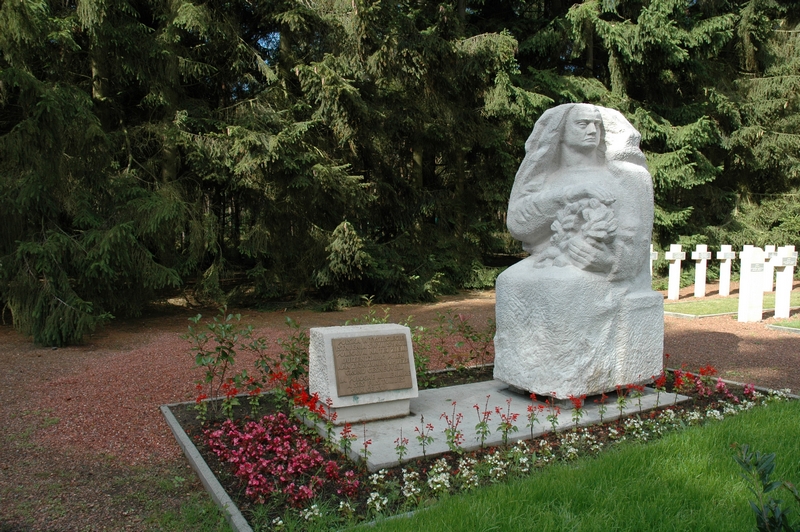 |
| photo: Eddy Van Deun |
The sad history of the Polish War Cemetery at Lommel.
It's remarkable to find this Polish Cemetery at Lommel in Belgium because Polish units didn't battle at all in this area. The reason is that there was an opportunity to buy a piece of wood there very cheaply; so that a cemetery could be established where all the Polish War Graves, spread across Belgium could be concentrated there.
History tells this didnít happen, therefore this small analysis.
257 Polish War graves from the municipalities mentioned below, were transferred to Lommel by the 84th British "Grave Concentration Unit" in 1947.
Aalter
Aken
Antwerpen
Arendonk
Baarle-Nassau
Beerse
Brugge
Gent
Henri Chapelle
Hooglede
Ieper
Knokke
Lapscheure
|
Lier
Merksplas
Oost Nieuwerkerke
Ostende
Roeselare
Ruiselede
Sint Niklaas
Sint-Denijs-Westrem
Sint-Eloois-Winkel
Turnhout
Weelde-Statie
Zandhengemolen
Zondereigen
|
But in the municipalities mentioned below 154 Polish War graves remained there. Why this happened in this way is difficult to follow.
Adegem
Antwerpen
Blankenberge
Brussel
Charleroi
Chievres
Heverlee
Hotton
De Klinge
Leopoldsburg
|
Lombardsijde
Middelkerke
Steken
Oostende
Sint-Niklaas
Sint-Pieters-Rode
Tielt
Wansin
Willebroek
|
For instance: from a cemetery at Turnhout the Polish War graves were transferred to Lommel, but from another cemetery, at Turnhout as well, the Polish
War graves were transported to the British "Leopoldsburg War Cemetery" at Leopoldsburg, so close to Lommel.
Whereas from the "Belgian Military Cemetery" Polish War Graves at Lier were transferred to Lommel.
In 1948 the supervision of the cemetery was given by the British Army to the Polish Government in Warsaw. From this moment on the Polish War Cemetery was a puppet of politics.
Very soon the anti-communist Polish old-combatants, who had a permit to stay in Belgium, built a big Cross in the middle of the cemetery. The Polish government reacted by placing a monument as big as a railway-carriage.
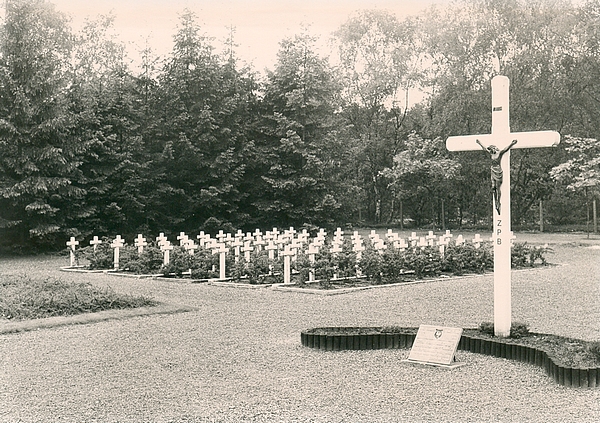 |
| The Cross in the middle of the cemetery |
Both groups had their yearly memorial service separately. The communist-oriented on the 1st Sunday of October and the Free Poles on the last Sunday of that month.
Up to the increase of terrorism in Poland less people visited the memorial service, which was organised by the communists. On the other hand the memorial service of the Free Poles was much more frequented.
Especially during the last years before the restoration of democracy in Poland the memorial service of the Free Poles grew into a political manifestation. After the official commemoration the visitors remained on the cemetery till dark to sing, to pray and to scan loudly "Solidarność...... Solidarność" while all the cemetery was lighted by thousands of lights. The visitors, however, lived between hope and fear, for the long arm of the Polish Secret Service reached as far as Lommel.
In the mean time the communist government didnít pay any attention to the Polish Cemetery. The whole became worse and worse and weeds throve everywhere. But also the crosses on the graves decayed seriously. The enamel on edges of plates on the graves began to came down and so they got a brown rusty border in such a undermining way, that on some plates the name was illegible. Industrious volunteers painted at random, so without pasting, a red brim around the plates. It all looked very shabby!
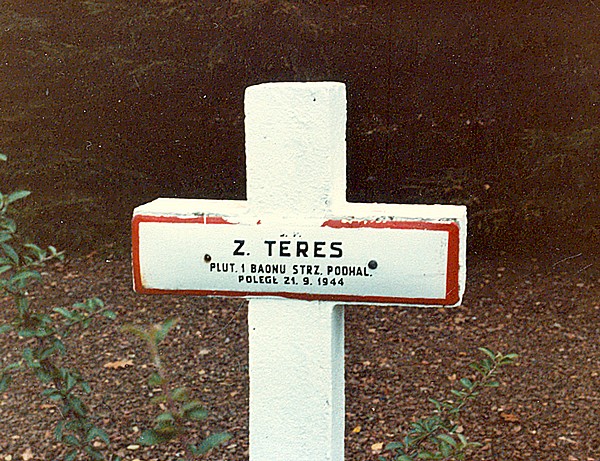 |
| Text plates into delay. |
After the restoration of democracy in Poland both parties, so the Free Poles and those who sympathized with the former Communistic Government in Poland, united. The two yearly
memorial services were melted together and in good deliberation the cross, which was standing in the centre of the burial-ground, was placed on top of the monument, as a symbol of this new harmony.
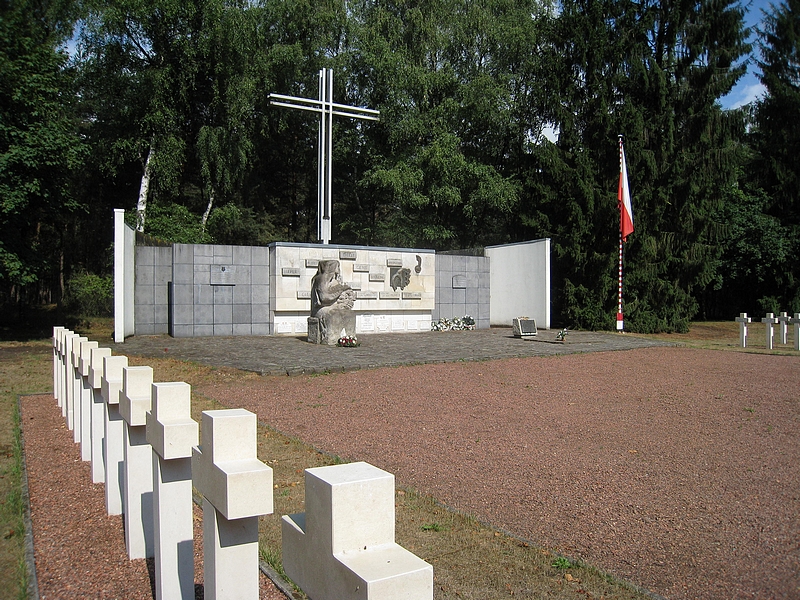 |
| photo: Eddy Van Deun |
Not everybody however agreed upon this, for in the art of sculpture it isnít usual to add something to an existing piece of art. That is, in fact, an objection of esthetical nature, but there is more.
The monument standing at the back of the cemetery, is a product of communistic, so atheistic, monumental art. The cross, on the other hand, is a symbol of religion and both expressions arenít tolerable in one monument. So, that is an ideological objection - of much more importance of course!
The new Polish Government took responsibility and in 1990 the burial-ground was renovated at last. Also new crosses of soft nature-stone were placed, on which new plates of artificial material were adjusted.
Alas, they worked slovenly in making the plates and more than a hundred mistakes in the text proved to be made.
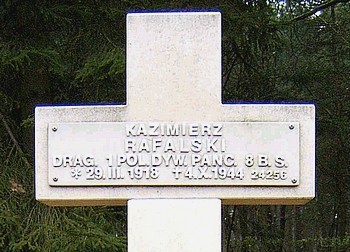 |
| New plate in 2000. |
Very soon it was also clear, that flimsy material had been used. The plates became warped. Thatís why very soon a screw was placed on the four corners Ė again very slovenly Ė but that was just a temporary solution. The problem went further, for the undressed iron screws, which were originally used to fasten the plates, started to rust. This rust pressed up the paint and the characters started to fall down.
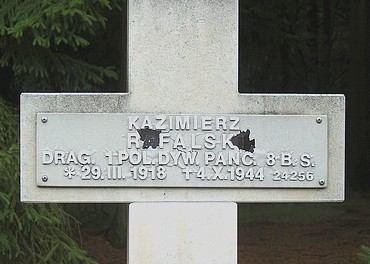 |
| The same plate in 2006 |
After much discord a new restoration was carried out in 2009. New plates were placed with another cementation.
The mistakes in the texts were corrected for the greater part, but they made 40 new mistakes !!!
It concerns the understanding graves:
The cross of KOWALSKI Roman is damaged.
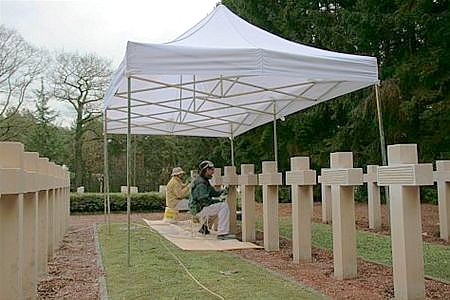 |
Polish restorers at work
Bron: http://www.internetgazet.be/lommel.aspx |
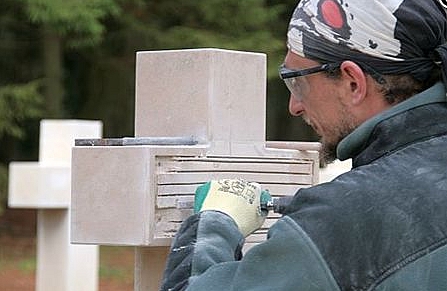 |
The plates are fastened in another way.
Bron: http://www.internetgazet.be/lommel.aspx |
 |
After the restoration in 2009
photo: Eddy Van Deun |
Now 257 Polish victims are resting in The Polish War Cemetery in Lommel.
BABIARZ Józef
BADURA Szczepan
BAGNUCKI Zygfryd
BARTKOWIAK Józef Kazimierz
BARTOSIŃSKI Marian
BARTOSZEK Franciszek
BAUMGART Franciszek
BEGGER Jan
BENDYK Zbigniew
BERNER Ignacy
BIELAWSKI Stanisław
BIELKA Jerzy
BILIŃSKI Józef
BŁĄKAŁA Franciszek
BONIK Jan
BOREK Antoni
BOY Jan Edward
BOŻEK Jan
BRAUER Bruno
BUDZIAK Henryk
BUKOWSKI Grzegorz
BUSZCZAK Władysław
BYNISZ Sylwester
CHODZIDŁO Augustyn
CHOJNACKI Wacław
CHRAPKOWSKI Jan Wilhelm
CICHY Stefan
CIEPIELA Aleksander
CIEPLIŃSKI Kazimierz
CIERZNIAKOWSKI Jan
CONER Bronisław
CWENAR Stanisław
CZAPLEWSKI Antoni
CZARNOWSKI J.
CZERWIEC Jan
DEJNA Franciszek
DEMBOWSKI Alfons
DĘBICKI Wacław Franciszek M.
DŁUGOBORSKI Antoni
DUDA Alfred
DZIATKOWSKI Henryk
DZIURDA Wojcieh
ELIASIEWICZ Witold Jan
ENGLOT Jan
FENGLER Jan
FILEK Jacek
FLASZA Władysław
FLIGIEL Edward
FRANISZEK Hubert
FRĄCKOWIAK Bolesław
FUNK Bronisław
GAWROŃSKI Jan
GEMBARA Edward Stefan
GERAT Franciszek
GLAŁBERT Edward
GLIŃSKI Alojzy
GŁOWACKI Wincenty
GOSŁAWSKI Marian
GRONOWSKI Paweł
GRYNIEWICZ Paweł
GRZELUK Antoni
HABURA Jan
HALASTRA Jan
HIPŚ Kazimierz
HUK Antoni
JACH Jan
JAKUBOWSKI Jan
JANKOWSKI Jerzy
JANKOWSKI Józef
JARZĄBEK Józef
JENCZ Paweł
JOCHNOWICZ Jakub
KALINOWSKI Józef
KAŁUŻA Paweł
KAMIEŃSKI Jerzy
KAMIŃSKI Kazimierz
KAMROWSKI Ignacy
KANIA Kazimierz
KARRASCH Bernard
KASIK-KASICKI Teofil Antoni
KASPRZYK Józef
KIEDOS Stefan
KIN Adolf
KIWACZ Rajmund
KLAWCZYŃSKI Leon
KLUSKA Edmund
|
KLUZ Nikodem Edward
KOŁEK Józef
KOMOROWSKI Antoni Eugeniusz
KORNEL Michał
KOŚCIUK Andrzej
KOTEWICZ Ignacy
KOWALSKI Roman
KOWERKO Jan
KOWNAS Wacław
KRUPA Franciszek
KRUŻYŃSKI Feliks
KRZECZEK Piotr
KRZEMIŃSKI Mieczysław
KRZYŻAKOWSKI Jerzy
KSIĄŻEK Stanisław
KUBICA Wiktor
KUCZOWICZ Wilhelm
KUKUŁKA Władysław
KULIKOWSKI Edmund
KUPKIEWICZ Antoni
KUŚNIERZ Karol Kazimierz
KWIATKOWSKI Andrzej
LAKS Franciszek
LEJA Andrzej
LENIEC Władysław
LEPPEK Jan
ŁOZA Piotr
MACKOWIAK Feliks (Nieznany)
MAJDA Zygmunt
MAKSYMIEC Szymon
MALANOWSKI Jan
MARASIŃSKI Benedykt
MARCIŃCZAK Stanisław
MARKIECKI Stefan
MARSZOLIK Alojzy
MASZYŃSKI Zenon
MATEJUK Józef
MAZURKIEWICZ Stanisław
MAZURKOWSKI Tadeusz
MĄKA Tadeusz
MELKOWSKI Czesław
MICHALAK Louis
MICHAŁEK Paweł
MICHUŁKA Stanisław
MIESZCZANIN Stefan
MIŚ Jan
MOCHNACKI Zygmunt Jan
MROZIŃSKI Józef
NANCKA Jerzy
NASZKE Franciszek
NIEZNANY ŻOŁNIERZ
NIEZNANY ŻOŁNIERZ
NIEZNANY ŻOŁNIERZ
NIEZNANY ŻOŁNIERZ
NIEZNANY ŻOŁNIERZ
NIEZNANY ŻOŁNIERZ
NIEZNANY ŻOŁNIERZ
NIEZNANY ŻOŁNIERZ
NIEZNANY ŻOŁNIERZ
NIEZNANY ŻOŁNIERZ
NIEWIEM Ernest
NOSKOWSKI-SAGAL Stefan
NOWACKI Franciszek
NOWICKI Adolf
NOWICKI Józef
NOWICKI Leon
NOWOTNY Zygmunt
OBŁOJ Władysław
OLEJARCZYK Jan
ORŁOWSKI Konrad
OSZMIAŃSKI Piotr
OWCZAREK Edward
PACER Antoni
PACHUCKI Ryszard
PACIORKOWSKI Stanisław
PALICA Stanisław
PAŁKOWSKI Edmund
PARADA Kazimierz
PIERÓG Andrzej
PIERZECKI Władysław
PILKOWSKI Bolesław
POWAŁKA Bronisław
POWIERZA Tadeusz
POZNAŃSKI Stefan
PRASCHILL Stefan Leopold A.
PRODAN Jan
|
PROKOP Tadeusz
PRZEPOLSKI Stanisław
PRZYBYSZEWSKI Stanisław
PUCHAC(S)Z Stefan
PUKAS Kazimierz
RACZYŃSKI Konrad Emil
RADCZYK Jakub
RADECKI Tadeusz
RAFALSKI Kazimierz
RASZKA Ryszard
RATAJ Jan
RATHNOW Klemens
ROSEN Juliusz
ROSIEK Władysław
ROZENSTRAUCH Jakub
RUŻAŃSKI Józef
RYNKOWSKI Józef
SADŁOWSKI Mieczysław
SALAMON Konstanty
SARO Tadeusz
SCHULTKA Jan
SEROKA Feliks
SIEWERT Antoni
SIKORA Józef Stanisław
SIKORSKI Kazimierz
SKIERKA Jan
SKROBACKI Konrad
SKRZYPEK Jan
SÓJKA Michał
SOLICH Eryk
SOSNOWSKI Henryk
SOZAŃSKI Wacław
SPILKA Paweł
STACHELSKI Edward
STADNIK Piotr
STALBOWSKI Igor
STANEK Wiktor
STANKIEWICZ Józef
STAWIARSKI Franciszek
STAWICKI Rajmund
STEBEL Paweł
STEINKE Teodor
STELMACH Kazimierz Czesław
STROGULSKI Henryk
STRUNK Józef
STRUZIK Stanisław
SUCHY Wiktor
SUMICZ Teodor
SZCZEPANIK Jan
SZCZEPAŃSKI Michał
SZELIŃSKI Alfons
SZATKOWSKI
SZOPA Jan
SZPERBER Adam Wacław
SZUMSKI Leon
SZWARNOWIECKI Zenon Ludwik
SZYDŁOWSKI Władysław
SZYMAŃSKI Edward
ŚLIŻEWSKI Bazyli
TERES Zygmunt
TOPER Jerzy Dymitr
TRUSIŁO Leon
TUSZER Stefan
WALAS Ignacy
WALASEK Stanisław
WASIEWICZ Bronisław
WASILEWSKI Kazimierz
WIELICZKO Wincenty
WIERZEJSKI Aleksander Stanisław
WIĘCKOWSKI Lucjan
WINCIOR Władysław
WINKLARZ Zdisław
WŁOCH Tadeusz Jan
WNUK-LIPIŃSKI Paweł
WODZIANUK Jan
WODZIK Franciszek
WÓJCIK Wojciech
WYRWIAK Bronisław
ZALESKI Jarosław
ZAPOTOCZNY Paweł
ZDROJEWSKI Stanisław
ZIENTARSKI Ludwik
ZINKA Klemens
ZYLBER Andrzej
ŻELIGOWSKI Wacław
|
LOCATION
The Polish War Cemetery, signed as " Pools Militair Kerkhof" is to be found in a large wood that bears the name "Kattenbos".
See understanding Map.
GOOGLE: 51º 12' 59.56" N 5º 21' 46.83" O
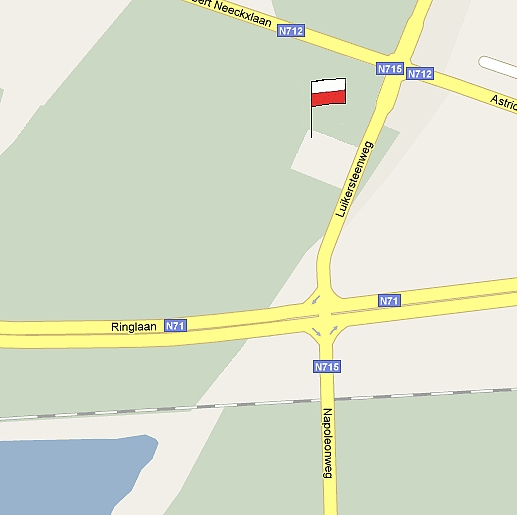
LOCATION of the GRAVES
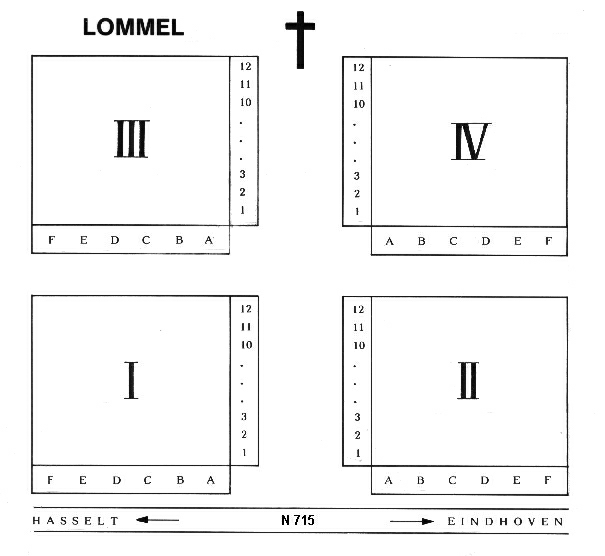
|











